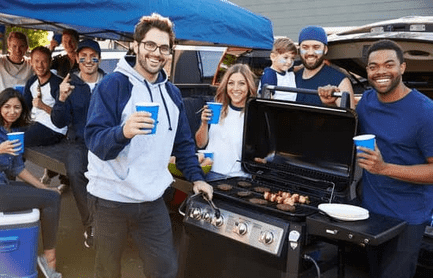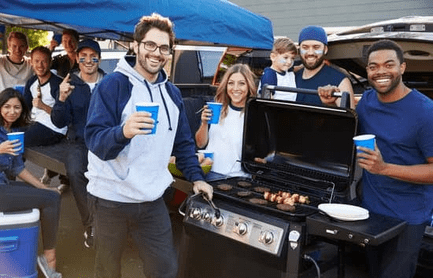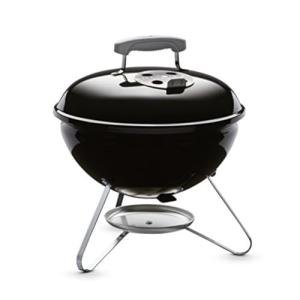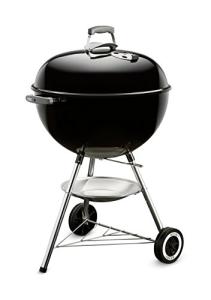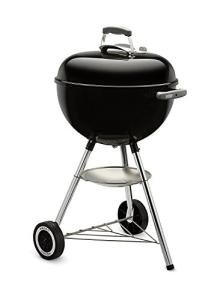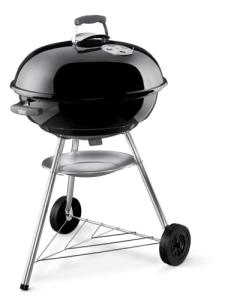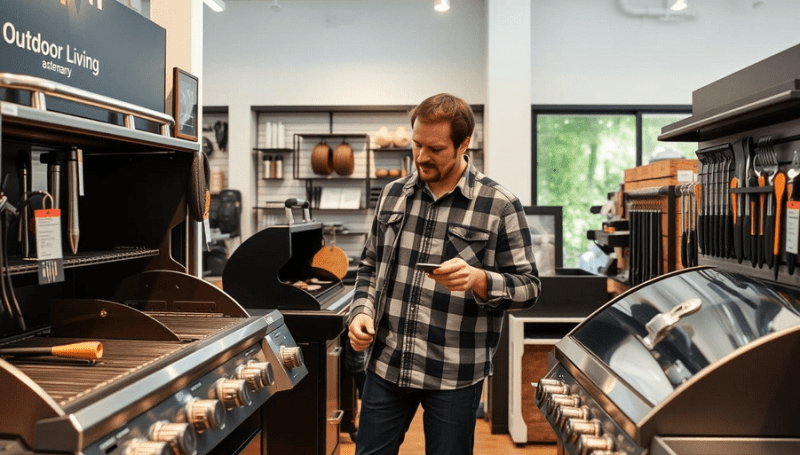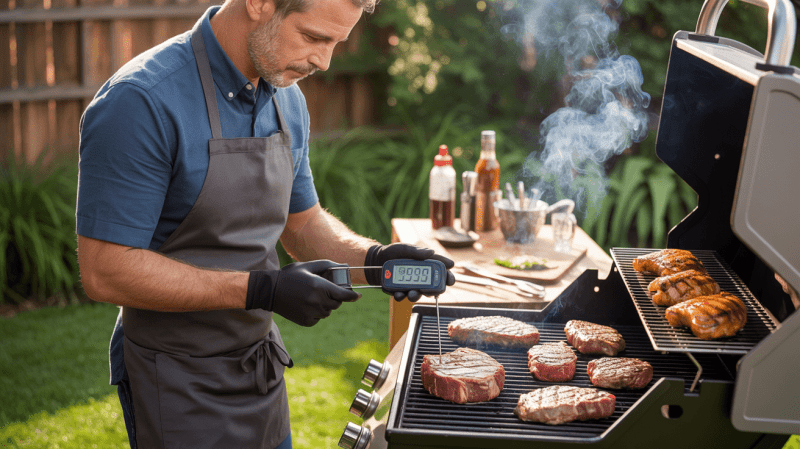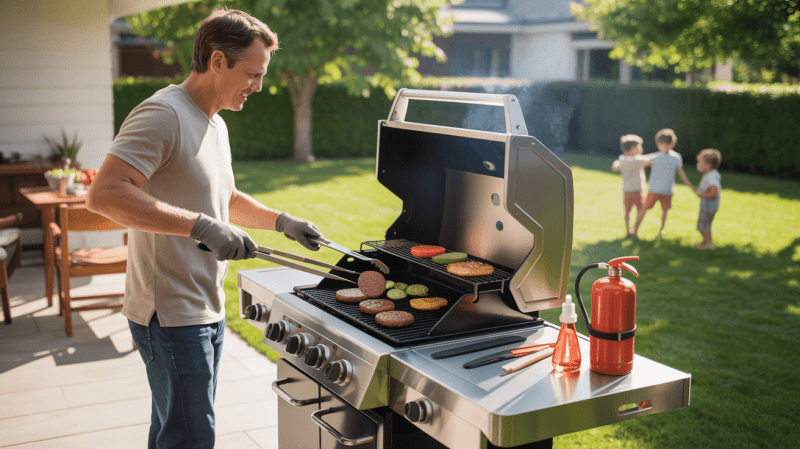Top Picks Portable Grill sizes for Camping and Tailgating:

I aim to simplify choosing the right grill size. This article explores the best portable grill sizes for camping and tailgating. It matches grill dimensions to outdoor needs, comparing cooking area, weight, and folded size. This helps you pick a grill that fits your vehicle and plans.
Choosing a grill involves tradeoffs. Larger cooking areas serve groups faster but weigh more. Propane grills like the Weber Traveler and the Weber Q1200 are different from charcoal grills like the Weber Go-Anywhere and the Everdure Cube. Pellet and heavy-duty tailgating units, such as the Traeger Tailgater and the Hitchfire Forge 15, also have unique considerations.
Features like foldable legs, lid locks, and handles make larger grills easier to handle. I use data from The Spruce Eats, SmokedBBQSource, and Serious Eats to support my recommendations. This gives you realistic expectations for tailgating and camping grills.
Key Takeaways
- Match cooking area to party size: more square inches for groups, less for solo trips.
- Weigh portability: folded dimensions and weight matter as much as the grate size.
- Fuel type affects capacity and transport—propane, charcoal, pellet, and electric differ.
- Look for practical features like fold-flat carts, handles, and lid locks to ease transport.
- Tested models from Weber, Traeger, Everdure, and NOMAD illustrate common size and weight tradeoffs.
Why grill size matters for camping and tailgating
https://www.youtube.com/watch?v=QSipTGY6vAs
I choose my grill size carefully. It affects what I can cook, how fast, and if it fits in my car. This makes choosing the right grill more than just looking at numbers.
How cooking area affects meal capacity and timing
The cooking area tells me how many burgers or steaks I can cook at once. A 100–150 sq in area is good for one or two people. For a small family, 150–300 sq in is better.
For big tailgates, over 300 sq in is best. It lets me cook in batches. This saves time when feeding a crowd.
Weight, dimensions, and fit in my vehicle
I always check if the grill fits in my car. Small grills like the Weber Q1200 fit easily in hatchbacks. But, bigger grills like the Weber Traveler or Traeger Tailgater need more space.
Lighter grills are easier to lift alone. But if I have help, I can handle bigger ones. Measuring before buying saves me from returns.
Portability features that compensate for larger sizes
Features like built-in carts and big wheels make big grills easier to use. Nomad-style grills and trailer mounts offer flexibility. They let me choose between small and large grills.
Removable grates and side shelves add to the grill's usefulness. They make portable grills feel like full kitchens without extra bulk.
Best portable grill sizes for camping and tailgating

I've sorted out grill sizes for you, so you can choose the perfect one for your adventures. Whether it's a small, mid-size, or large grill, there's something for everyone. I've tested real models and highlighted the trade-offs between size, weight, and features.
Small grills for solo or duo camping trips (under ~150 sq in)
For solo or duo trips, I recommend a small portable BBQ. These grills fit on a picnic table and are easy to carry. The Weber Smokey Joe series and the Everdure Cube are great for quick meals like steaks and foil packets.
They're affordable, easy to carry, and simple to clean. But, they have a small cooking area and fewer temperature controls. If you're hiking, look for a grill under 15–16 lbs for easy transport.
Mid-size grills for small groups and families (~150–300 sq in)
This size is perfect for families and small groups. Mid-size grills offer enough space for meals without being too heavy. The Weber Q1200 and the Weber Go-Anywhere rectangular are great examples.
Look for features like porcelain grates, electronic ignition, and easy cleanup. These grills can cook multiple items at once. Be prepared for a slightly heavier load and possibly a more stable table.
Large portable grills for parties and big tailgates (300+ sq in)
For big gatherings, I choose large portable grills. They have plenty of space and hold heat well. The Weber Traveler and the Traeger Tailgater pellet model are top picks for their power.
They offer a lot of cooking area and consistent heat. But, they're heavy and need two people or a cart to move. For tailgating, look for grills with easy transport options.
| Size Class | Typical Sq In | Best For | Representative Models |
|---|---|---|---|
| Small | Under ~150 | Solo or duo trips, tabletop use | Weber Smokey Joe, Everdure Cube |
| Mid-size | ~150–300 | Families, small groups | Weber Q1200, Weber Go-Anywhere, NOMAD suitcase grills |
| Large | 300+ | Parties, big tailgates | Weber Traveler, Hitchfire Forge 15, Traeger Tailgater |
How fuel type changes ideal size and portability
I think about fuel early when choosing a grill for a trip. Fuel impacts weight, space, startup time, and cooking options. Here's a look at the pros and cons of matching size to use.
Propane grills and size tradeoffs
I chose a tailgating gas grill for fast heat and easy handling. Propane grills light quickly, offer steady heat, and control temperature well. Small models use 1-lb cylinders, while larger ones take 20-lb tanks with adapters.
I've tested grills like the Weber Traveler and the Coleman Q1200. Lighter models weigh under 20 pounds and fit in trunks easily. Bigger grills offer more space, but they are heavier and more difficult to move.
Charcoal grills and flavor vs. bulk
For flavor, I pick a portable charcoal BBQ. Charcoal grills offer deep smoke and high sear temperatures. Small kettles like the Weber Smokey Joe are light and great for crusts, while cast-iron ones are heavier.
Charcoal grills take time to start and cool. I carry extra fuel and plan for ash disposal. This bulk makes them less portable than gas grills, but many prefer the flavor.
Pellet grills and power requirements for larger portable units
Pellet grills for camping offer smoking and grilling with digital control. Units like the Traeger Tailgater have 300 sq in of surface and a long-lasting hopper. They need electricity, so I plan for a 120V outlet, inverter, or portable generator.
Pellet systems are heavy and complex. I choose them for long, steady cooks when I can supply power. For truly mobile use, I need a plan for batteries or an AC source, affecting the size I pick.
Electric and tabletop alternatives for restricted venues
In places with no open flame, I use an electric tabletop grill. Models like the Weber Lumin heat up fast and fit on picnic tables. They have nonstick surfaces and wood-chip smoke options for outdoor flavor.
Electric grills limit me to places with power. They simplify packing but require an electrical cord. I consider this when picking a grill for parks, rooftops, or stadium tailgates.
Compact portable grills and size comparison for outdoor cooking

I test compact portable grills to give you the facts. I look at size, weight, and how well they work. My goal is to help you choose the right grill for camping, travel, or tailgating.
Compact grill size comparison table (what I look for)
| Model | Cooking Area (sq in) | Weight (lbs) | Fuel | BTU/Temp | Key Features | Ease of Cleaning |
|---|---|---|---|---|---|---|
| Weber Smokey Joe | 103–147 | 9.5 | Charcoal | N/A | Budget, classic kettle, lid locks as base | Removable grate, simple ash pan |
| Everdure Cube | 115 | 15.4 | Charcoal | Up to 600°F | Modern design, no full lid | Grates lift out, compact ash control |
| Weber Q1200 | 189 | 29.1 | Propane | 8,500 BTU | Side tables, cast-iron grates | Drip tray, removable parts |
| Weber Traveler | 320 | 49–50 | Propane | 13,000 BTU | Fold-flat cart, wheels | Large drip pan, easy access |
| Traeger Tailgater | 300 | 62 | Pellet | 175–450°F | Smoke flavor, requires power | Grease bucket, removable grate |
| NOMAD Suitcase | 212 | 28 | Charcoal | Varies | Foldable suitcase design | Simple ash tray, compact parts |
| Weber Go-Anywhere | 160 | 20 | Charcoal | N/A | Budget, locking legs/lid | Easy-clean ash pan |
Choosing between travel-friendly and roomy tailgating grills
I choose grills based on the number of people I'm cooking for and how I plan to travel. For solo or duo trips, I look for grills under 150 sq in and under 20 lbs. This makes packing and setting up easier.
For small families, I choose grills with 150–300 sq in. These offer a good balance between cooking area and portability. For big tailgates, I opt for 300+ sq in grills with wheeled carts to make moving gear easier.
I also check if the grill is allowed at the venue. And I consider power needs for pellet and electric grills, as access can be a problem.
Top-rated camping grills and portable tailgating grills from testing
In my reviews, I focus on real-world use. I look at heat control, setup speed, and how easy they are to clean. The Weber Traveler is great for its size and fold-flat cart. The Weber Q1200 is versatile with its side tables and cast-iron grates.
The Weber Go-Anywhere is a budget-friendly option for quick trips. The Traeger Tailgater is top for smoke flavor and temperature range. NOMAD's suitcase design is convenient for packing. These grills are often recommended because they balance size, features, and portability.
I suggest choosing a grill based on your cooking style, the number of people you cook for, and venue rules before making a purchase.
Buying guide: picking the right portable grill dimensions and features
I keep my camping grill buying guide simple and to the point. This way, I can quickly find the right gear. I consider how many people I cook for, how I'll move the grill, and what cleaning will be like. I also think about which fuels work best with the grill.
Assess how many people I typically cook for
I match the grill size to the number of people. For one or two, I look at grills like the Weber Smokey Joe or Everdure. They have about 100–150 sq in. For families or small groups, I prefer the Weber Q1200 or Go-Anywhere with 150–300 sq in. For big gatherings, I choose grills with 300+ sq in, like the Traeger Traveler.
Consider weight, handles, foldable legs, and cart options
I check the grill's lift points and handle strength before buying. Grills with foldable legs save space and work well on tables. I avoid grills with cheap plastic handles that can melt. If the grill is 40–70 lbs, I look for carts or wheels from Weber and Traeger to make moving easier.
I also look for leg locks and lid locks. Grills like the Weber Go-Anywhere and kettle designs with Tuck-N-Carry locks are great for travel. They stay secure during transport.
Look for easy clean-up and durable construction.
I prefer grills with removable drip trays and porcelain-enameled cast iron grates. These grates sear well and clean up fast. Grills with stainless steel or cast aluminum bodies also last longer, which is important for long trips.
I check how well the grill manages grease and how easy parts are to remove. A lightweight grill that's also durable is the best for frequent use.
Fuel and accessory considerations
I choose fuel based on my needs. Propane is great for convenience at tailgates, while charcoal offers better flavor for camping. Pellet grills offer smoking options but require a power source. Electric grills are good for places where open flames are banned.
I ensure the grill accepts common fuel sizes and accommodates accessories like griddles and extra grates. When choosing a portable BBQ for tailgating, I check which accessories fit the model. Accessories can change how I use the grill.
| Need | Example Models | Key Feature | Why it fits |
|---|---|---|---|
| Solo/duo camping | Weber Smokey Joe, Everdure | ~100–150 sq in, lightweight | Small cooking area, easy to carry, low fuel use |
| Family/small group | Weber Q1200, Weber Go-Anywhere, NOMAD | 150–300 sq in, sturdy handles | Balances capacity and portability, table-top friendly |
| Large gatherings/tailgate | Traeger Traveler, Hitchfire | 300+ sq in, cart or wheels | High capacity, accessory-ready, best portable grill options for parties |
| Road trips/vanlife | Foldable camping grill models, compact pellet units | Foldable legs, low pack volume | Easy stow in tight cargo spaces, saves weight |
I use this checklist to make my final decision. I look for the right cooking area, secure handles, easy cleanup, and fuel compatibility. This approach helps me pick the best portable BBQ or camping grill without hesitation.
Real-world usage tips for camping and tailgating with portable grills
I always think about practicality when I pack a transporting camping grill. For short trips, I prefer an easy to carry camping grill or a lightweight grill. This saves space and time when setting up.
When loading grills, I protect my vehicle and the campsite. Heavier grills go on a cart or with a second person. I keep propane canisters separate and store pellets in sealed bags. For charcoal, I wrap the ashtray in heavy-duty foil to avoid spills.
Setting up a portable grill for outdoor cooking requires a stable surface. I avoid plastic tables and use a heat-proof barrier on wood or metal tables. I also keep the grill away from paint and flammable materials for safety.
For feeding a crowd, I use heat zones and staging. I preheat to target temps and create hot and cool sides on charcoal units. This method reduces movement and keeps food hot.
For coal and ash disposal, I let the coal burn down fully if no hot-coal barrels are available. I scoop cooled embers into aluminum foil, douse with water, then bag and dispose as per park rules. Never toss hot coals in regular trash.
Below is a compact checklist I follow for safe, fast outings with a portable grill for outdoor cooking.
| Task | Why it matters | My quick tip |
|---|---|---|
| Packing and transport | Prevents spills and trunk damage | Use covers, carts, and secure fuel separately |
| Surface choice | Reduces fire risk and heat damage | Place on metal or wood with a heat barrier |
| Safe tailgating grill setup | Keeps people and cars safe | Keep a clear space around grill and monitor flare-ups |
| Cooking workflow | Speeds service and preserves food quality | Create heat zones and stage prep on side surfaces |
| Coal and ash disposal | Prevents fires and park violations | Cool completely, wrap in foil, douse with water |
| Choosing gear | Balances weight, capacity, and ease | Opt for an easy-to-carry camping grill when I hike; pick a lightweight grill for outdoor activities for longer drives |
Conclusion
When choosing a grill, remember: size matters. For solo or duo trips, go for a compact grill, about 100–150 sq in. They're easy to carry and heat up fast.
For families, a mid-size grill of 150–300 sq in is perfect. It's big enough for everyone and easy to move around. For large gatherings, pick a grill over 300 sq in. It ensures you can cook plenty of food.
The type of fuel you use also plays a big role. Propane grills are great for their convenience and control. Charcoal grills offer rich flavors and high heat. Pellet grills are versatile, needing power, while electric grills are perfect for places with no open flame.
Testing top-rated grills helped me make better choices. The Weber Traveler and Weber Q1200 are top picks for gas grills. For charcoal, the Weber Go-Anywhere, Weber Smokey Joe, and Everdure Cube are excellent.
Pellet and specialty grills include the Traeger Tailgater and NOMAD suitcase-style options. The Hitchfire Forge 15 is great for hitch-mounted tailgating. These grills show the best sizes for tailgating.
Use the buying guide I shared to find the right grill. Look at the cooking area, weight, dimensions, fuel type, and portability. Also, consider how easy it is to clean. These tips will help you choose the best grill for camping and tailgating.
FAQ
Q: How do I choose the best portable grill size for camping vs. tailgating?
A: Choose based on your group size and how you'll carry the grill. For solo or duo trips, go for 100–150 sq in grills like the Weber Smokey Joe or Everdure Cube. For families and small groups, 150–300 sq in grills such as the Weber Q1200 or NOMAD are best. For large gatherings, choose grills with a surface area of 300 sq in or more, such as the Weber Traveler, Traeger Tailgater, or Hitchfire Forge 15. Also, consider the fuel type, folded size, and if you can handle >30 lbs alone or need wheels/carts.
Q: How does the cooking area in square inches translate to meal capacity?
A: Cooking area directly affects how many items you can cook at once. Serious Eats and The Spruce Eats suggest 100–150 sq in can fit 2 burgers or a couple of ears of corn, good for 1–2 people. Around 150–300 sq in supports small families and groups. For larger tailgates, choose 300+ sq in grills like the Weber Traveler, Hitchfire Forge, or Traeger Tailgater.
Q: What weight and dimensions should I consider for vehicle fit and carrying?
A: Weights range from under 15 lbs for compact charcoal units (Weber Smokey Joe, Everdure Cube ~15.4 lbs) to 49–70 lbs for cart-style or hitch-mounted grills (Weber Traveler 49–50 lbs, Traeger Tailgater 62 lbs, Hitchfire Forge 70 lbs). Check the folded and open dimensions—Weber Traveler folds flat to fit many SUVs, Q1200 measures about 20.5 x 40.9 x 24.6 inches. If you carry solo, aim for
Q: How do foldable legs, carts, and handles affect portability?
A: Portability features can make up for larger size. Look for fold-flat carts and wheels (Weber Traveler), suitcase folding (NOMAD), lid-locking legs (Weber Go-Anywhere), and trailer-hitch mounting (Hitchfire). These make transport and setup easier. Choose sturdy handles, locking lids, and foldable legs for tabletop use or frequent moves.
Q: Should I choose propane, charcoal, pellet, or electric for camping and tailgating?
A: Choose based on your priorities. Propane is fast and convenient, with steady BTUs (Weber Q1200, Weber Traveler 13,000 BTU). Charcoal offers superior smoky flavor and high sear temps (Everdure Cube hits ~600°F) but needs extra time and ash handling. Pellet grills (Traeger Tailgater) give smoker versatility and consistent control but require power and are heavier. Electric (Weber Lumin) works where fuels are banned but needs an outlet or inverter.
Q: What are the pros and cons of small portable charcoal grills?
A: Pros: lightweight, budget-friendly, great flavor, high sear temps (Weber Smokey Joe, Everdure Cube). Cons: limited capacity (under ~150 sq in), longer startup and cool-down, ash disposal, and sometimes less precise temperature control.
Q: Are mid-size portable grills a good compromise?
A: Yes. Mid-size grills around 150–300 sq in strike a balance between capacity and portability. Models like the Weber Q1200 (189 sq in, 29 lbs) and NOMAD (≈212 sq in) let you feed small families while fitting in many vehicle trunks. Expect slightly more weight and often extra features like side tables and removable drip trays.
Q: What do I need to know about large portable grills for tailgates?
A: Large portable grills (300+ sq in) handle big groups and multi-zone cooking but are heavier and bulkier. Look for fold-flat carts, wheels, or hitch-mount options to manage transport. These units deliver faster group cook times and better heat retention but may require two people to move and sometimes a power source (Traeger Tailgater pellet requires power).
Q: How much does fuel type affect transport weight and packing?
A: Fuel matters. Charcoal is bulkier to pack and requires ash containment. Propane canisters are lighter per cook but require safe stowage—many portables use 1-lb canisters or accept 20-lb adapter tanks (Weber Traveler). Pellet grills need pellets and power, adding weight and accessory needs. Electric grills depend on available power and may need extension or inverter solutions.
Q: What features improve cleanup and durability in portable grills?
A: Prioritize removable drip trays, porcelain-enameled cast iron grates for searing and easy release, stainless or cast-aluminum bodies, and accessible ash pans. Models with removable grates and simple grease management speed post-cook cleanup. Tests show porcelain-coated grates sear well and are easier to clean than basic steel grates.
Q: Which tested models are the best references for size and use cases?
A: Use these tested models as benchmarks: Weber Traveler (best overall for tailgating — 320 sq in, 49–50 lbs, fold-flat cart), Weber Q1200 (versatile mid-size gas — 189 sq in, 29 lbs), Weber Go-Anywhere and Weber Smokey Joe (compact charcoal/budget — ~160 & ~103–147 sq in, light), Everdure Cube (115 sq in, 15.4 lbs, high sear temps), Traeger Tailgater (portable pellet — 300 sq in, 62 lbs), NOMAD (suitcase-style portability, 212–425 sq in depending on config), and Hitchfire Forge 15 (hitch-mounted — 335 sq in, 70 lbs).
Q: How should I pack and transport grills to avoid damage and mess?
A: Use the grill’s folded form or suitcase case where available (NOMAD, Traveler). Secure propane canisters separately, bag pellets in sealed containers, and use heavy-duty foil or a dedicated ash bucket to contain residual coals. Load heavy units on carts or place them low in the vehicle. Cover grills to protect finishes and prevent grease leaks.
Q: What are safe setup practices at campsites or tailgates?
A: Avoid plastic tables and keep grills on stable, heat-resistant surfaces. Maintain distance from vehicles, tents, and flammable materials. Use heatproof barriers where necessary, secure lid locks for transport, and monitor grease to prevent flare-ups. Follow park/stadium rules about approved fuel types.
Q: How do I match grill size to the number of people I usually cook for?
A: Match capacity to group size: 1–2 people — ~100–150 sq in; 3–5 people — 150–300 sq in; 6+ or tailgates — 300+ sq in. Consider cook style: if you grill a lot of sides or want multi-zone cooking, err toward the larger end of the range.
Q: Any tips for efficient group cooking workflows outdoors?
A: Preheat fully, set up multiple heat zones (direct/indirect), stage foods by cook time, and use side tables or prep surfaces. Sear high-heat items first, then move to indirect heat to finish. Keep tools, trays, and a service station close to minimize trips away from the grill.
Q: What’s the safest way to dispose of charcoal and ash at campsites?
A: Let coals burn down and cool completely. Transfer cooled ash and embers into heavy-duty aluminum foil or a metal container, douse with water until cold to the touch, and dispose per campground rules. Never dump hot coals in trash or on the ground; use designated disposal areas where provided.
Q: Are pellet grills practical for portable use?
A: Pellet grills like the Traeger Tailgater provide excellent temperature control and smoke flavor but are heavier (~62 lbs) and need electricity for the auger and controller. They’re practical if you have access to power (120V or inverter) and want smoker versatility; choose propane or charcoal for simpler portability.
Q: Can electric grills replace gas or charcoal for camping and tailgating?
A: Electric grills (Weber Lumin) work well where open flames or fuels are banned and can reach high temperatures, sometimes with smoke infusion options. They require a reliable power source and are best for venues with outlets or when paired with a generator or inverter.
Q: How often should I prioritize portability features over cooking area?
A: Prioritize portability when you’ll be solo-carrying, backpacking to a campsite, or have limited trunk space—aim for compact, lightweight units under ~20–30 lbs with foldable legs or suitcase designs. If you routinely cook for larger groups or host tailgates, favor cooking area and choose grills with carts or wheels to handle the extra weight.
Q: What accessories should I consider when buying a portable grill?
A: Consider cover bags, travel cases, griddles or alternative grates, compatible cart or hitch mounts, extra grates, propane adapters (1-lb to 20-lb), a small power inverter for pellet grills, and reliable cleaning tools. These extend versatility and make transport, cooking, and cleanup easier.
DISCLAIMER
This document is provided for general information purposes only and should not be relied upon as providing legal advice, technical, or specific operational guidance to the reader, whether as to the practices described in the document or the applicable legal requirements and regulations. outdoorgrillguide.com expressly disclaims any responsibility for liability arising from or related to the use or misuse of any information in this document.
